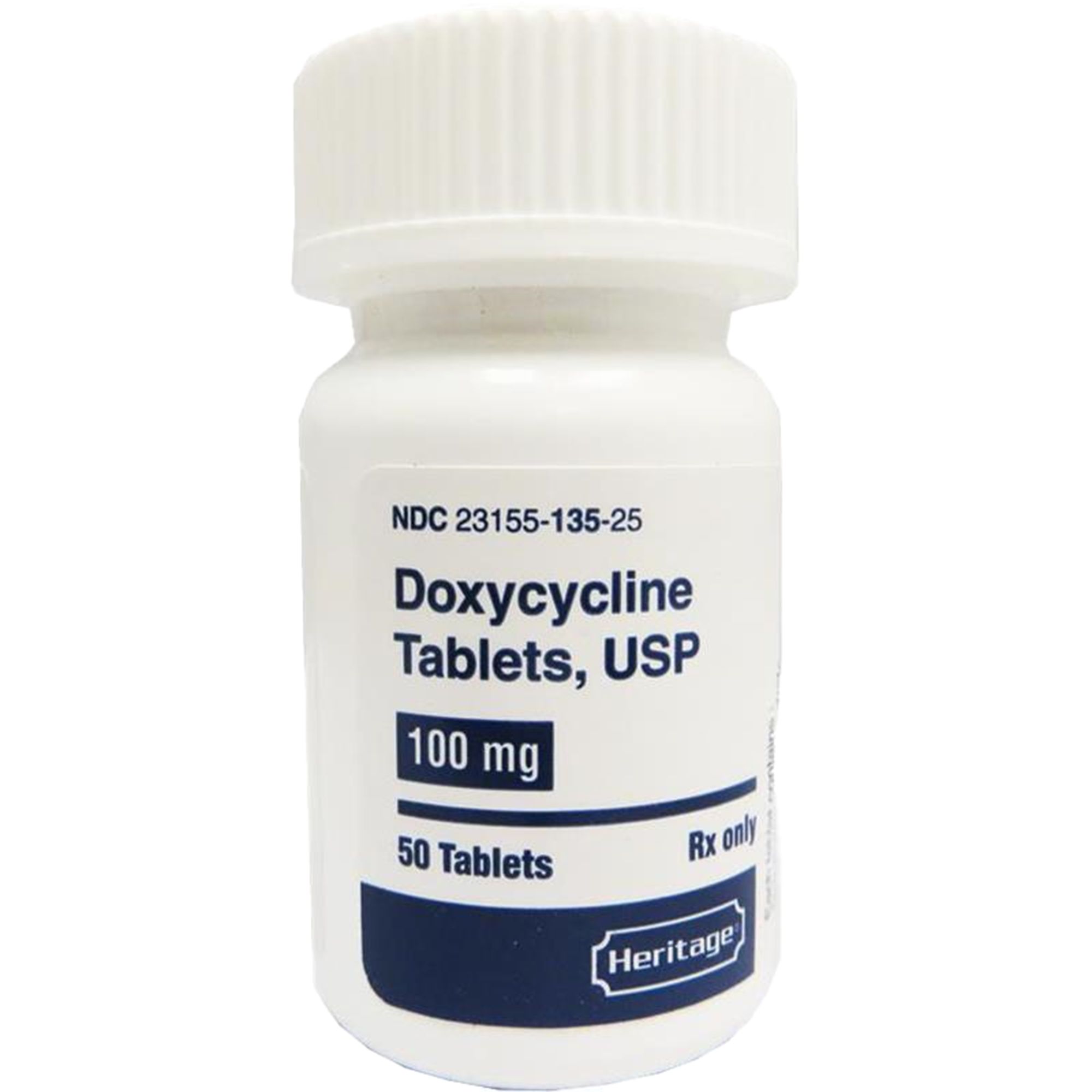Doxycycline monohydrate is a semi-synthetic antibiotic derived from oxytetracycline, a member of the tetracycline class of antibiotics. It has been widely used in human and veterinary medicine for its efficacy against a broad spectrum of bacteria. The drug’s mechanism of action involves inhibiting protein synthesis in bacteria by binding to the 30S ribosomal subunit, which is essential for the translation of mRNA into proteins. This binding prevents the aminoacyl-tRNA from attaching to the ribosomal acceptor site, thereby halting the addition of new amino acids to the growing peptide chain and effectively stopping the production of essential proteins necessary for bacterial growth and replication.
Uses of Doxycycline Monohydrate
Doxycycline monohydrate is prescribed for a variety of bacterial infections due to its broad-spectrum activity. It is effective against both Gram-positive and Gram-negative bacteria, including certain atypical bacteria. The primary uses include the treatment of:
- Acne: Doxycycline is commonly used for the treatment of moderate to severe acne, particularly inflammatory forms. It works by reducing the population of Propionibacterium acnes (P. acnes) on the skin, which is involved in the pathogenesis of acne. Additionally, it has anti-inflammatory properties that contribute to its effectiveness.
- Respiratory Tract Infections: Doxycycline is indicated for the treatment of respiratory tract infections caused by susceptible bacteria, such as community-acquired pneumonia, bronchitis, and sinusitis.
- Urinary Tract Infections (UTIs): It is used to treat UTIs, including pyelonephritis and cystitis, caused by susceptible bacteria.
- Sexually Transmitted Diseases (STDs): Doxycycline is effective against certain STDs like chlamydia and syphilis.
- Lyme Disease: It is a recommended treatment for early stages of Lyme disease.
- Malaria Prophylaxis: Doxycycline can be used as a prophylactic measure against malaria for travelers to endemic areas.
- Anthrax: It is an approved treatment for inhalational anthrax (post-exposure) and cutaneous anthrax.
Comparative Analysis of Doxycycline with Other Antibiotics
When considering the use of doxycycline monohydrate, it’s essential to understand its position within the broader spectrum of antibiotics. Compared to other tetracyclines, doxycycline has a longer half-life, allowing for less frequent dosing and potentially better compliance. It is also known for its relatively favorable side effect profile compared to some other antibiotics. However, it is crucial to use doxycycline judiciously due to the risk of antibiotic resistance.
Dosage and Administration
The dosage of doxycycline monohydrate can vary based on the specific condition being treated, the severity of the disease, and the patient’s renal function. It is typically administered orally in the form of capsules or tablets, and it can be given once or twice daily. For adults, the usual dose ranges from 100 mg to 200 mg per day. In some cases, like the treatment of acne, lower doses (20 mg) are used to minimize side effects while still providing therapeutic benefits.
Potential Side Effects and Contraindications
While doxycycline monohydrate is generally well-tolerated, it can cause side effects such as gastrointestinal upset (nausea, vomiting, diarrhea), photosensitivity, and, rarely, more severe reactions like Stevens-Johnson syndrome or anaphylaxis. It is contraindicated in pregnancy and children under the age of 8 due to the risk of inhibiting bone growth and causing permanent tooth discoloration. Additionally, it should be used with caution in patients with hepatic impairment and those with known hypersensitivity to tetracyclines.
Future Trends and Developments
The development of antibiotic resistance poses a significant challenge to the continued effectiveness of doxycycline monohydrate and other antibiotics. Research into new mechanisms of action and the development of novel antibacterial agents is crucial. Furthermore, the optimization of current prescribing practices to minimize the risk of resistance is a vital area of ongoing work. This includes the promotion of antibiotic stewardship programs that ensure the appropriate use of antibiotics.
Practical Application Guide
For individuals prescribed doxycycline monohydrate, it is essential to:
- Take the medication as directed, completing the full course of treatment even if symptoms improve before finishing.
- Avoid taking it with dairy products, aluminum, calcium, magnesium, or iron-containing preparations due to potential interference with absorption.
- Use sunscreen and protective clothing to avoid photosensitivity reactions.
- Report any side effects to a healthcare provider promptly.
Resource Guide for Further Information
For those seeking more detailed information on doxycycline monohydrate or its applications, the following resources may be helpful:
- The Centers for Disease Control and Prevention (CDC) for guidance on the treatment of infectious diseases.
- The National Institutes of Health (NIH) for the latest research on antibiotic resistance and new antibacterial therapies.
- The Food and Drug Administration (FDA) for drug safety information and prescribing guidelines.
Decision Framework for Prescribing Doxycycline Monohydrate
When considering doxycycline monohydrate as a treatment option, healthcare providers should weigh the benefits against the potential risks and consider the following factors:
- The nature and severity of the infection.
- The susceptibility of the causative organism to doxycycline.
- Patient-specific factors such as age, renal function, and history of allergies.
- The potential for interactions with other medications.
- The presence of any contraindications.
Step-by-Step Guide to Addressing Side Effects
In the event of side effects, patients should:
- Monitor Symptoms: Keep track of the severity and duration of side effects.
- Consult a Healthcare Provider: Report any side effects to a healthcare provider.
- Adjust Dosage or Medication: Under the guidance of a healthcare provider, adjust the dosage or switch to an alternative medication if necessary.
- Practice Self-Care: Engage in practices that can mitigate side effects, such as taking the medication with food to reduce gastrointestinal upset.
FAQ Section
What is the standard dosage of doxycycline monohydrate for treating acne?
+The standard dosage for acne treatment can range from 50 mg to 100 mg per day, with some dermatologists prescribing lower doses (20 mg) for mild cases to minimize side effects.
Can doxycycline monohydrate be used in pregnancy?
+No, doxycycline monohydrate is contraindicated in pregnancy due to the risk of inhibiting bone growth and causing permanent tooth discoloration in the fetus.
How long does it take for doxycycline monohydrate to start working?
+The onset of action can vary depending on the condition being treated, but improvements in symptoms can be observed within a few days of starting the medication. It's crucial to complete the full course of treatment as prescribed by a healthcare provider.
Myth vs. Reality: Addressing Misconceptions about Doxycycline Monohydrate
- Myth: Doxycycline monohydrate is ineffective against Gram-negative bacteria.
- Reality: Doxycycline monohydrate has a broad spectrum of activity that includes both Gram-positive and Gram-negative bacteria, making it effective against a wide range of bacterial infections.
- Myth: It can be used during pregnancy without risk.
- Reality: Due to the risk of tooth discoloration and inhibition of bone growth in the fetus, doxycycline monohydrate is contraindicated in pregnancy.
Case Study: Application of Doxycycline Monohydrate in Clinical Practice
In a recent clinical case, a patient presented with symptoms of community-acquired pneumonia. Following diagnostic testing, the causative organism was identified as Streptococcus pneumoniae, which was susceptible to doxycycline monohydrate. The patient was prescribed a 7-day course of doxycycline monohydrate at a dosage of 100 mg twice daily. Significant improvement in symptoms was observed within 3 days, and the patient completed the full course of treatment without reporting any significant side effects. This case highlights the effectiveness of doxycycline monohydrate in treating bacterial infections when used appropriately.
In conclusion, doxycycline monohydrate is a valuable antibiotic for the treatment of various bacterial infections, offering a balance of efficacy, safety, and convenience. Its broad-spectrum activity, combined with its relatively favorable side effect profile, makes it a preferred choice for many conditions. However, like all antibiotics, it must be used judiciously to minimize the risk of resistance and ensure its continued effectiveness in the future.



